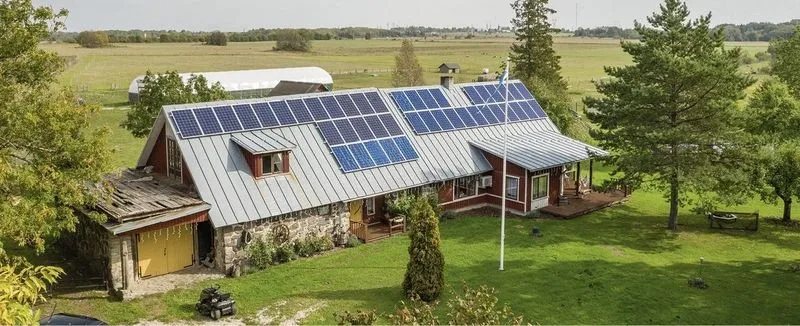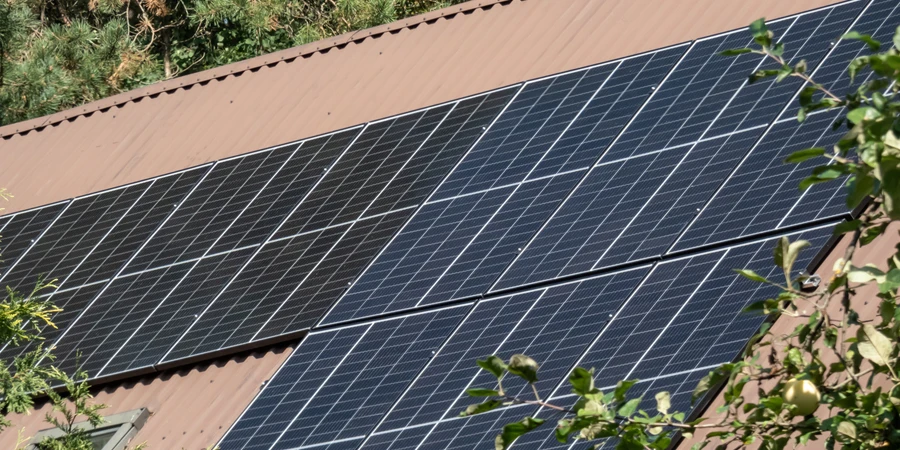In recent years, the Baltic countries have experienced a solar generation boom as the region seeks to kill two birds with one stone. These nations aim to break away from years-long energy dependence on Russia amid growing security concerns while also continuing to prioritize the green energy transition.

The outbreak of hostilities in Ukraine was a wake-up call for the Baltic nations, signaling the urgent need for changes to energy policies.
“The energy crisis following the aggression of the Russian Federation against Ukraine in 2022 for sure had an impact on all neighboring countries,” Andres Meesak, smart energy solutions lead at Estonian regional distribution system operator (DSO) Viru Elektrivõrgud, told pv magazine.
The Baltic states of Latvia, Lithuania, and Estonia have learned a great deal from the unfortunate experience of Ukraine as they must also live in the shadow of its belligerent eastern neighbor.
“The main positive impact has been understanding the threat to energy infrastructure and using energy and energy infrastructure as a hybrid weapon against societies by the aggressor,” Meesak said. “The conflict forced the countries to speed up separation from energy cooperation [with the Russian Federation] of any kind – frequency stability, fuel supply, electricity transit.”
Circuit breakers
Most European countries used to be somewhat dependent on Russia for energy but, for the Baltic nations, this issue has a different dimension. The three countries remain part of the Soviet-era “BRELL” circuit, with Russia and Belarus, relying on Russian operators to control frequency and balance supply and demand.
In 2018, Latvia, Lithuania, and Estonia hammered out a plan to decouple from BRELL and join the EU power grid by late 2025. The events in Ukraine forced the countries to reconsider the time frame and speed up the transition. Other steps are also needed to improve the security of their energy grid.
“The war against Ukraine demonstrated clearly the weaknesses of centralized energy supply compared to distributed generation in smaller units,” Meesak said, suggesting that it impacted society at all levels, from households to top government officials.
In addition to the political rationale, Baltic investors got strong economic incentives to invest in solar power as energy costs in the region went through the roof. At the peak of the 2022 European energy crisis, electricity consumers saw their bills rise nearly sevenfold, compared with the previous year.
Against this background, the years 2022 to 2024 have seen solar power generation growth across the Baltic region beat even the most optimistic forecasts.
The uptake of PV has really taken off in Estonia. Mihkel Annus, chairman of the Estonian Renewable Energy Chamber, said that installed capacity has doubled each year. In only five years, as of the end of 2023, total installed solar capacity stood at 812 MW, up from 39.6 MW in 2018.
Lithuania exceeded its 2025 target for solar power generation, of 1.2 GW, in 2023, according to data from the Lithuanian Energy Agency (LEA). The country has welcomed nearly 300 MW of new capacity over the last few years.
In Latvia, approximately 300 MW of solar capacity was installed as of January 2024, said Anna Rozīte, head of business development for AJ Power Group. This figure has roughly tripled since May 2023 alone.
Solar power enjoyed an investment boom in Latvia and other Baltic countries as market players primarily opted for solutions that could be implemented as quickly as possible.
“Solar panel installations probably are the fastest projects, from an implementation standpoint, including the relatively short period for technical design stage and permitting, as well as the availability of necessary equipment,” Rozīte explained.
Upward trend
Market players believe the growth experienced so far might only be the prelude to a real Baltic solar boom in the coming years. The PV potential of the Baltic nations is estimated at 40 GW, said Rachel Andalaft, managing director of REA Consult. She added that the green energy sector in the Baltic countries is expected to attract €150 billion ($162 billion) of investment opportunities in the next 20 to 25 years.
It’s expected that solar industry development will be accompanied by the deployment and integration of battery energy storage systems (BESS), enhancement of interconnections with other European countries, and the necessary emergence of a market for power purchase agreements (PPAs) to the benefit of a decentralized generation landscape, said Andalaft. And there is already a significant amount of capacity in the pipeline.
Based on official data from Elering AS, the national transmission system operator (TSO), nearly 3.5 TWh of solar energy production are due to be added to the Estonian energy mix through 2026. Local market players indicated that this could potentially cover half of Estonia’s annual electricity consumption. Still, a number of big projects from 2022 haven’t gone live yet. The commissioning of solar power plants can take as long as two years, for projects with up to 15 MW of capacity, to connect at the DSO level, and more than three years for projects above 15 MW to connect at the TSO level, said Gatis Macans, executive director of the Latvian Solar Energy Association.
“After the renewable hype in 2022, when there was high competition to book grid capacity, in 2023 we started to see newly constructed solar power plants mainly connected to the distribution grid with capacity up to 15 MW. However, much larger PV projects are under development and we hope to see a few commissioned projects in the nearest two years,” Macans said.
Permits have been issued for 3.6 GW of solar connections, as well as an additional 1.6 GW for hybrid projects combining solar and/or wind, and energy storage. Latvian state energy operator Sadales tīkls, in turn, estimated that the DSO currently reserves 830 MW for prospective solar power plants. The Lithuanian government’s official target is to reach 4 GW of installed solar capacity by 2030.
“[In 2024 and 2025], at least two to five times more solar power parks should be built [in Lithuania] than were built in the entire period until then,” said Tomas Janususkia, associate partner with Widen, a Vilnius-based law firm.
The solar frenzy is seen at every level of the economy. Consumers installed twice as much residential solar in 2022 alone as in the entire period before that, Janususkia said, adding that households in Lithuania are eligible for state aid on solar installations up to 10 kW in size, while for industry, the figure is set at 500 kW. Streamlining regulations for renewables generation installations has also had an effect.
“The current legal regulation has basically simplified the construction of solar power plants,” Janususkia said. “It does not require either spatial planning documents, environmental impact assessment – except for exceptional cases – or land-use change. The introduced model of the hybrid power plant, together with wind power plants or accumulators, significantly facilitated and made the use of electricity networks and loads more efficient.”
Overcoming obstacles
Despite progress, challenges for the Baltic solar industry remain. Several factors could jeopardize further capacity growth, primarily fears that having so much solar power in the energy mix may be difficult.
“The challenge [for Estonia] is now to fit production to demand,” said Meesak. BESS could play a key role, he claimed, adding that the industry can see how diverse renewable energy parks have grown in importance, with solar, wind, and storage complementing each other.
“Although in 2024 we can expect to have several hours where solar energy output exceeds the total electricity demand in Estonia, it is still an unrealistic expectation to say that, in 2026, at least 50% of demand will be covered by solar, due to relatively low-capacity factor [actual output versus the theoretical maximum] and increased electricity demand in darker and colder winter months,” Annus said. As a result, the daytime spot prices during sunny hours are lower and more volatile, he added.
The maximum winter consumption in Estonia is about 1.6 GW. Stakeholders are looking at adding battery storage to their systems or optimizing the positioning of panels to increase the capture price from the market. Meesak said that decreasing battery storage costs motivated households to install more hybrid solar systems with local storage, offering some autonomy in case of power cuts.
“The daily demand-supply curve shows potential for affordable four- to six-hour local storage – the market price for electricity is highest during evening hours, right after PV plants fade out, up to about midnight. To even out the supply and demand, and through that also the market price, four- to six-hour storage at reasonable cost is needed,” Meesak said.
REA Consult’s Andalaft said she agreed that “storage facilities are absolutely necessary to expand the penetration rate of renewables while keeping grid stability, on one side, and enabling new operational modes on the other.” Andalaft also believes there are other issues that need to be tackled to ensure solar industry growth in the long run.
“Demand follows policies,” she said. “In the pandemic period, we saw peak prices both in [capital expenditure] and in electricity. The market today is still dealing with the aftermath of this. If, during the pandemic, the deployment suffered delay and constraints, today the lack of a dynamic PPA market is limiting investment appetite and holding back the potential for a diverse and private-equity driven, competitive energy landscape.”
In Lithuania, solar industry development has also faced some unexpected bureaucratic obstacles.
Janususkia explained that under the energy communities model introduced in the country, consumers, energy communities, and large electricity producers must connect to limited energy infrastructure networks simultaneously. For this reason, quotas have been assigned to network capacity.
“This resulted in a series of legal disputes over grid power shortages for power producers, acting as a brake on solar investment,” explained Widen’s Janususkia. “Currently, these issues have been partially resolved but the intensity of investment has decreased significantly and the available projects on the market are not in a hurry to be implemented.”
Despite these challenges, market players say that they remain confident that nothing can derail the solar industry’s growth in the Baltic region in the foreseeable future.
By Ian Skarytovsky
This content is protected by copyright and may not be reused. If you want to cooperate with us and would like to reuse some of our content, please contact: editors@pv-magazine.com.
Source from pv magazine
Disclaimer: The information set forth above is provided by pv-magazine.com independently of Alibaba.com. Alibaba.com makes no representation and warranties as to the quality and reliability of the seller and products.




